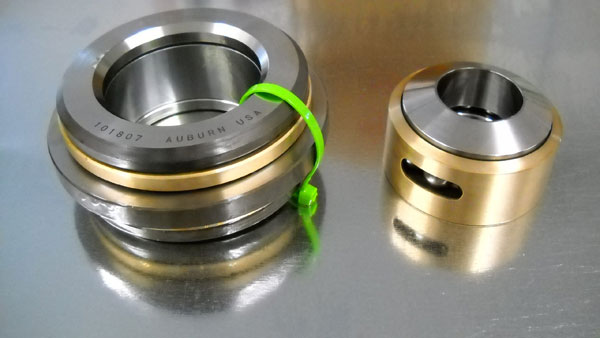Banded Ball Thrust Bearing
Banded ball thrust bearings are self-aligning, symmetrical bearings designed for axial loads. They are available in bore and OD measurements from 0.313 to 6.5 inches and in a height range of 0.31 to 1.5 inches. They are ideal for medium-duty axial load applications.
Banded ball thrust bearings are engineered to support axial forces in a single direction
Banded ball thrust bearings are designed to support axial forces in a single plane and may be used in various industrial applications. They are available with a wide range of load capacities, including up to 50% of the static radial load rating. They feature barrel-shaped rolling elements and a design resembling standard tapered roller bearings. This design is ideal for heavy axial thrust and moderate radial loads. However, the axial/radial load ratio is dependent on the angle between the bearing axis and the roller axis.
Banded ball thrust bearings are used in industries that require high axial load capacities. They typically contain steel cages to improve durability and service life. They also feature grooved outer raceways to promote smooth operation. Typical applications for PEW thrust bearings include vertical shaft bearings and steering columns.
Banded ball thrust bearings are manufactured from steel material and have spherical housing washers and inner rings. They are available in single and double-direction styles and in various sizes. Their applications range from agricultural machinery to material handling equipment to home appliances.

They are used in a variety of medium duty axial load applications
Banded ball thrust bearings are used for axial loads and exhibit low noise and smooth operation. They are suitable for medium-speed applications, such as rotary tables. This type of bearing is easy to install and requires little maintenance.
Banded ball thrust bearings feature barrel-shaped rolling elements that resemble the cone-and-cup design of standard tapered roller bearings. They are often self-aligning and can handle heavy axial loads. They also support moderate radial loads. The ratio of axial to radial loading is determined by the angle between the roller axis and bearing axis.
Banded ball thrust bearings are available in different types. Among them are preloaded, separable, and dual-way. The first type is characterized by a continuous, constant load, while the latter type is preloaded to accommodate a variable load. The second type is characterized by two-way operation, which allows it to support axial loads in either direction. This type of bearing usually requires a second complement of rolling elements and a thrust washer.
Another type is the tapered roller bearing, which consists of two hollow cone sections that support a ring of balls. Both of these bearing types are designed to handle moderate to high speeds and potential misalignment.
They are self-aligning
Banded ball thrust bearings are self aligning and feature a spherical surface around the raceway. They have a cage made of a copper alloy and a guide sleeve on the inner ring. Their design allows them to accommodate misalignment up to one degree and is particularly suitable for applications that involve axial and radial loads.
Banded ball thrust bearings are available in many sizes and are designed to withstand moderate thrust loads and high speeds. These self-aligning bearings have precision steel balls that are mounted in cold-formed races and feature a softer steel band that provides a unitized assembly and protects the bearing from wear and corrosion.
Another type of self-aligning ball bearing is the double row self-aligning ball bearing. These self-aligning ball bearings have two rows of balls and an outer spherical ring. The spherical outer ring is designed to allow the inner ring to deflect relative to the outer ring member. This self-aligning property automatically corrects shaft deflection, which can occur with mounting errors or whip. It also helps to minimize the bending influence of the shaft.
They feature large, symmetrical balls
Banded ball thrust bearings feature large symmetrical balls and can be made to accommodate various shaft diameters. They are self-aligning and have high load-carrying capacities. These bearings are commonly used in electric motors and are available in various sizes. They are also available with tapered surfaces.
These bearings are characterized by steel cages, which help to keep them symmetrical. They also feature oil lubrication and grooved races that ensure a stable alignment. They are ideal for applications involving heavy or moderate loads. Their large size and symmetrical ball design makes them suitable for external environments.
Ball thrust bearings are used to support axial loads. The bearings are typically made with two or more bearing balls supported by a cage. These bearings are great for low-axial loads, and can be made of different materials. The spherical shape of these bearings produces small contact points, resulting in smooth and efficient motion. In addition, they are able to accommodate misalignments in the outer raceway.
- Previous: Factors to Consider When Selecting a Needle Roller Thrust Bearing
- Next: Guide to Thrust Roller Bearings











